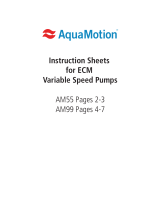
English (GB)
2
English (GB) Installation and operating instructions
Original installation and operating instructions
CONTENTS
These installation and operating instructions describe ALPHAx.
Sections 1-6 give the information necessary to be able to unpack,
install and start up the product in a safe way.
Sections 6-17 give important information about the product, as
well as information on service, fault finding and disposal of the
product.
CONTENTS
Page
1. General information
1.1 Target group
1. General information
2
1.1 Target group
2
1.2 Symbols used in this document
3
1.3 Other important notes
3
2. Receiving the product
3
2.1 Inspecting the product
3
2.2 Scope of delivery
3
3. Installing the product
4
3.1 Mechanical installation
4
3.2 Control box positions
4
3.3 Control box positions, ALPHA SOLAR
5
3.4 Insulating the pump housing
6
4. Electrical installation
6
4.1 Assembling the plug
7
4.2 Disassembling the plug
8
4.3 Electrical installation, ALPHA SOLAR
8
4.4 Power supply connection, ALPHA SOLAR
8
4.5 Control signal connection, ALPHA SOLAR
8
5. Starting up the product
9
5.1 Before startup
9
5.2 Venting the pump
9
5.3 Venting the heating system
9
5.4 First startup
9
6. Product introduction
10
6.1 Product description
10
6.2 Applications
10
6.3 Pumped liquids
11
6.4 Identification
11
7. Control functions
13
7.1 Elements on the control panel
13
7.2 Display
13
7.3 Light fields indicating the pump setting
13
7.4 Light field indicating the status of automatic night
setback
13
7.5 Button for enabling or disabling of automatic night
setback
13
7.6 Button for selection of pump setting
14
7.7 Control modes
14
7.8 Pump performance
16
7.9 Bypass valve
17
8. Operating the product
17
8.1 Using automatic night setback
17
8.2 Function of automatic night setback
18
8.3 Setting manual summer mode
18
8.4 Dry-running protection
18
8.5 ALPHA Reader
18
8.6 High-torque start
18
9. Fault finding
19
10. Technical data and installation dimensions
20
10.1 Technical data
20
10.2 Dimensions, ALPHAx XX-40, XX-50, XX-60, XX-80
21
10.3 Dimensions, ALPHAx 25-40 A, 25-60 A
22
11. Performance curves
23
11.1 Guide to performance curves
23
11.2 Curve conditions
23
11.3 Performance curves, ALPHAx XX-40 (N)
24
11.4 Performance curves, ALPHAx XX-50 (N)
25
11.5 Performance curves, ALPHAx XX-60 (N)
26
11.6 Performance curves, ALPHAx 25-40 A
27
11.7 Performance curves, ALPHAx 25-60 A
28
11.8 Performance curves, ALPHAx XX-80 (N)
29
12. Accessories
30
12.1 Unions and valve kits
30
12.2 Insulating shells
30
12.3 ALPHA plugs
31
13. ALPHA SOLAR
31
13.1 Product introduction
31
13.2 Application
31
13.3 Product description
31
13.4 Operating the product
31
13.5 Setting by means of the control panel
31
13.6 Operating status
31
13.7 Alarm status
31
13.8 Operating status
32
13.9 Fault finding the product
32
14. External PWM control mode and signals
33
15. Digital solar-circuit controller
33
16. Technical data
33
17. Disposing of the product
35
Prior to installation, read this document and the quick
guide. Installation and operation must comply with
local regulations and accepted codes of good
practice.
This appliance can be used by children aged from 8
years and above and persons with reduced physical,
sensory or mental capabilities or lack of experience
and knowledge if they have been given supervision
or instruction concerning use of the appliance in a
safe way and understand the hazards involved.
Children shall not play with the appliance. Cleaning
and user maintenance shall not be made by children
without supervision.






















